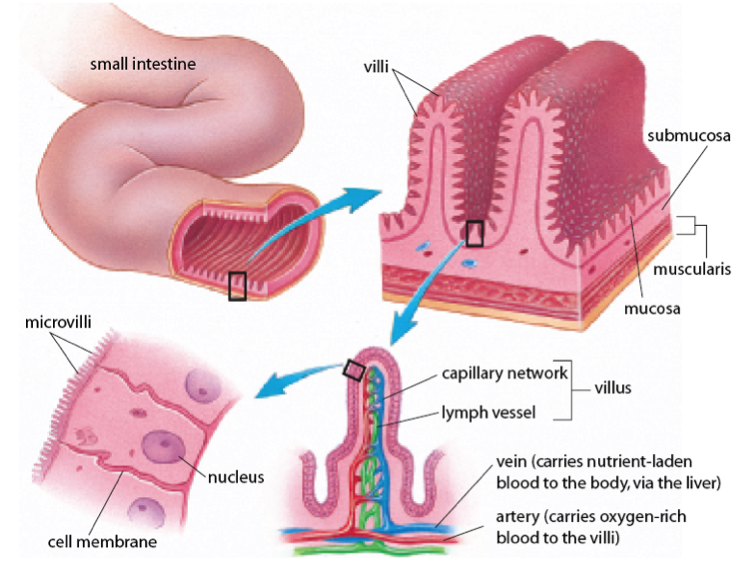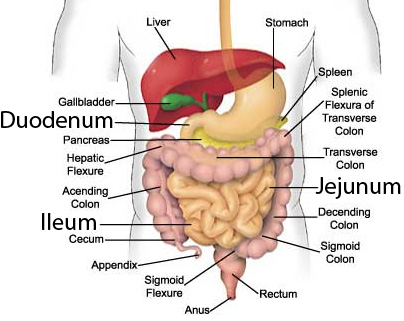The small intestine is part of your digestive system. It makes up part of the long pathway that food takes through your body, called the gastrointestinal (GI) tract. When food leaves your stomach, it enters the small intestine, also called the small bowel. The small bowel connects to the large bowel, also called the large intestine or colon.
Small intestine | Digestive Function, Structure & Length | Britannica
What membrane holds the coils of the small intestine together? Small Intestine: The small intestine is part of the gastrointestinal tract that is located between the stomach and

Source Image: scribd.com
Download Image
The first straight portion of the small intestine is called the duodenum, the curled portion is the ileum. The ileum is held together by a membrane called the mesentery. Note the blood vessels running through the mesentery, they will carry absorbed nutrients away from the intestine. Absorption of digested nutrients occurs in the small intestine

Source Image: sciencedirect.com
Download Image
Book – Text-Book of Embryology 12 – Embryology
The membrane that holds the coils of small intestine together: Mesentery: This organ is found under the liver and stores bile: Gall Blagger: What are the three lobes of the liver called? Right, Left Anterior, and Left Posterior: The organ that is the first major site of chemical disgestion: Stomach: Eggs, sperm, urine and wastes all empty into
![When size matters: the first comprehensive anatomical study of a species of “Condylocardiidae”, an extremely miniaturized bivalve [PeerJ]](https://dfzljdn9uc3pi.cloudfront.net/2021/12108/1/fig-8-2x.jpg)
Source Image: peerj.com
Download Image
Membrane That Holds The Coils Of The Small Intestine
The membrane that holds the coils of small intestine together: Mesentery: This organ is found under the liver and stores bile: Gall Blagger: What are the three lobes of the liver called? Right, Left Anterior, and Left Posterior: The organ that is the first major site of chemical disgestion: Stomach: Eggs, sperm, urine and wastes all empty into
The pancreas is involved in the digestion and the uptake of sugars. Color the pancreas yellow. The coils of the small intestine are held together by a thin membrane called the mesentery. Color it pink. A female frog will have tiny curling tubes deep in the abdominal cavity that carry eggs. Color the oviducts red.
When size matters: the first comprehensive anatomical study of a species of “Condylocardiidae”, an extremely miniaturized bivalve [PeerJ]
Post Lab Questions. 1. The membrane holds the coils of the small intestine together: 2.This organ is found under the liver, it stores bile: 3. Name the 3 lobes of the liver: 4. The organ that is the first major site of chemical digestion: 5. Eggs, sperm, urine and wastes all empty into this structure: 6. The small intestine leads to the: 7. The esophagus leads to the: 8.
Conductive and Eco-friendly Biomaterials-based Hydrogels for Noninvasive Epidermal Sensors: A Review | ACS Biomaterials Science & Engineering

Source Image: pubs.acs.org
Download Image
Small Intestine – Digestive System
Post Lab Questions. 1. The membrane holds the coils of the small intestine together: 2.This organ is found under the liver, it stores bile: 3. Name the 3 lobes of the liver: 4. The organ that is the first major site of chemical digestion: 5. Eggs, sperm, urine and wastes all empty into this structure: 6. The small intestine leads to the: 7. The esophagus leads to the: 8.

Source Image: pathwayofasandwich.weebly.com
Download Image
Small intestine | Digestive Function, Structure & Length | Britannica
The small intestine is part of your digestive system. It makes up part of the long pathway that food takes through your body, called the gastrointestinal (GI) tract. When food leaves your stomach, it enters the small intestine, also called the small bowel. The small bowel connects to the large bowel, also called the large intestine or colon.

Source Image: britannica.com
Download Image
Book – Text-Book of Embryology 12 – Embryology
The first straight portion of the small intestine is called the duodenum, the curled portion is the ileum. The ileum is held together by a membrane called the mesentery. Note the blood vessels running through the mesentery, they will carry absorbed nutrients away from the intestine. Absorption of digested nutrients occurs in the small intestine

Source Image: embryology.med.unsw.edu.au
Download Image
Circular Folds – an overview | ScienceDirect Topics
Nov 3, 2023The small intestine is the longest part of the digestive system. It extends from the stomach ( pylorus) to the large intestine ( cecum) and consists of three parts: duodenum, jejunum and ileum. The main functions of the small intestine are to complete digestion of food and to absorb nutrients. Dysfunction of the small intestine can bring you

Source Image: sciencedirect.com
Download Image
21 Small Intestine ideas | anatomy and physiology, physiology, microscopic photography
The membrane that holds the coils of small intestine together: Mesentery: This organ is found under the liver and stores bile: Gall Blagger: What are the three lobes of the liver called? Right, Left Anterior, and Left Posterior: The organ that is the first major site of chemical disgestion: Stomach: Eggs, sperm, urine and wastes all empty into

Source Image: pinterest.com
Download Image
Function of the small intestine in the human digestive system | Science online
The pancreas is involved in the digestion and the uptake of sugars. Color the pancreas yellow. The coils of the small intestine are held together by a thin membrane called the mesentery. Color it pink. A female frog will have tiny curling tubes deep in the abdominal cavity that carry eggs. Color the oviducts red.

Source Image: online-sciences.com
Download Image
Small Intestine – Digestive System
Function of the small intestine in the human digestive system | Science online
What membrane holds the coils of the small intestine together? Small Intestine: The small intestine is part of the gastrointestinal tract that is located between the stomach and
Book – Text-Book of Embryology 12 – Embryology 21 Small Intestine ideas | anatomy and physiology, physiology, microscopic photography
Nov 3, 2023The small intestine is the longest part of the digestive system. It extends from the stomach ( pylorus) to the large intestine ( cecum) and consists of three parts: duodenum, jejunum and ileum. The main functions of the small intestine are to complete digestion of food and to absorb nutrients. Dysfunction of the small intestine can bring you